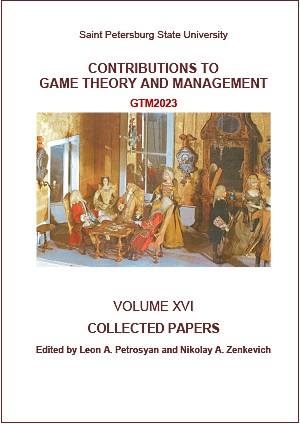Cooperative Solutions in Multi-Star Network Games
Abstract
A model also known as multi-agent systems, namely the multi-star model is considered. In a multi-agent system, a two-level game is played,
the first-level is the external game, and the second-level is the internal game.
An approach is proposed how to distribute the benefits to players in the
first-level game and the second-level game. The characteristic functions are
constructed for the multi-star model. Based on the proposed characteristic
functions, the combination of the Shapley value and the proportional solution as natural optimal principle to distribute the benefits in the first-level
game and in the second-level game is proposed.
Keywords:
multi-agent system, the Shapley value, the proportional solution
Downloads
References
Bulgakova, M. A. (2018). About construction of characteristic function in game with pairwise interactions. Proceedings of international conference Control Processes and Stability, 2018, 53–58.
Bulgakova, M. A. (2019). Solutions of network games with pairwise interactions. Vestnik of Saint Petersburg University. Applied Mathematics. Computer Science. Control Processes, 15(1), 147–156.
Bulgakova, M. A. and L. A. Petrosyan (2015). The Shapley value for the network game with pairwise interactions. 2015 International Conference "Stability and Control Processes" in Memory of V. I. Zubov (SCP).
Bulgakova, M. A. and L. A. Petrosyan (2020). Multistage Games with Pairwise Interactions on Complete Graph. Automation and Remote Control, 81, 1519–1530.
Chun, Y. (1988). The proportional solution for rights problems. Mathematical Social Sciences, 15(3), 231–246.
Hernandez, P., Munoz-Herrera, M. and A. Sanchez (2013). Heterogeneous network games: Conflicting preferences. Games and Economic Behavior, 79, 56–66.
Pankratova, Y. B. and L. A. Petrosyan (2018). About new characteristic function for multistage dynamic games. Vestnik of Saint Petersburg University. Applied Mathematics. Computer Science. Control Processes, 14, 316–324.
Petrosyan, L. A., Bulgakova, M. A. and A. A. Sedakov (2019). The Time-Consistent Shapley Value for Two-Stage Network Games with Pairwise Interactions. In: Song, J., Li, H., Coupechoux, M. (eds) Game Theory for Networking Applications. EAI/Springer Innovations in Communication and Computing. Springer, Cham. https://doi.org/10.1007/978-3-319-93058-9_2
Petrosyan, L., Sedakov, A. (2019). Two-Level Cooperation in Network Games. In: Avrachenkov, K., Huang, L., Marden, J., Coupechoux, M., Giovanidis, A. (eds) Game Theory for Networks. GameNets 2019. Lecture Notes of the Institute for Computer Sciences, Social Informatics and Telecommunications Engineering, vol 277. Springer, Cham. https://doi.org/10.1007/978-3-030-16989-3_5
Shapley, L. S. (1988). A value for n-person games. The Shapley Value Essays in Honor of Lloyd S. Shapley. Ed. by A. E. Roth, 31–40.
Zhonghao, P. (2012). Research on China-Korea FTA Negotiation Scheme Based on Second-Level Game Theory.
Downloads
Published
How to Cite
Issue
Section
License
Articles of "Contributions to Game Theory and Management" are open access distributed under the terms of the License Agreement with Saint Petersburg State University, which permits to the authors unrestricted distribution and self-archiving free of charge.




